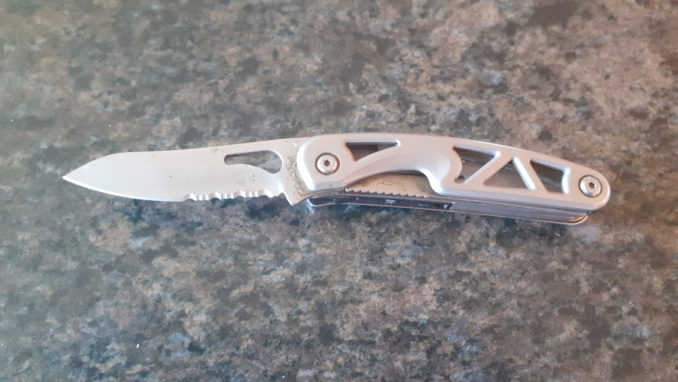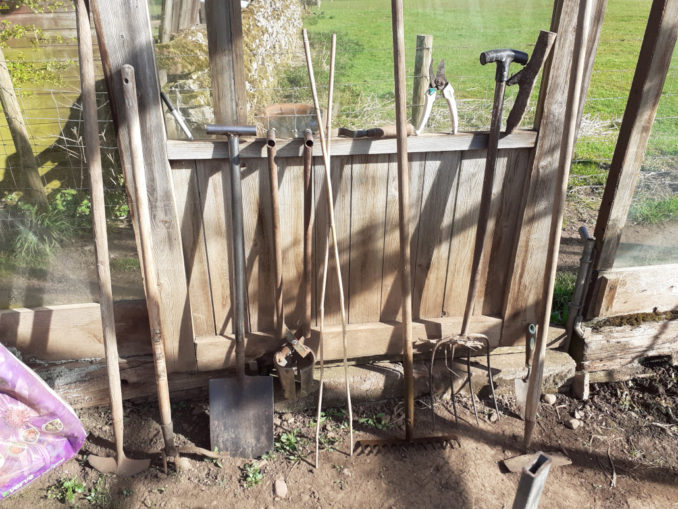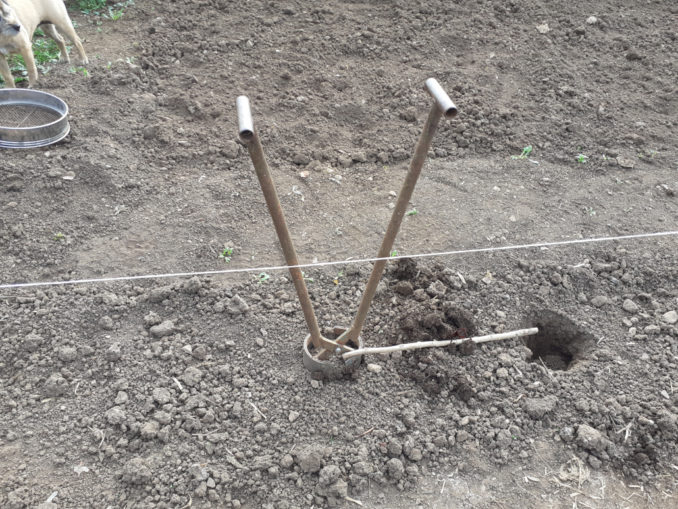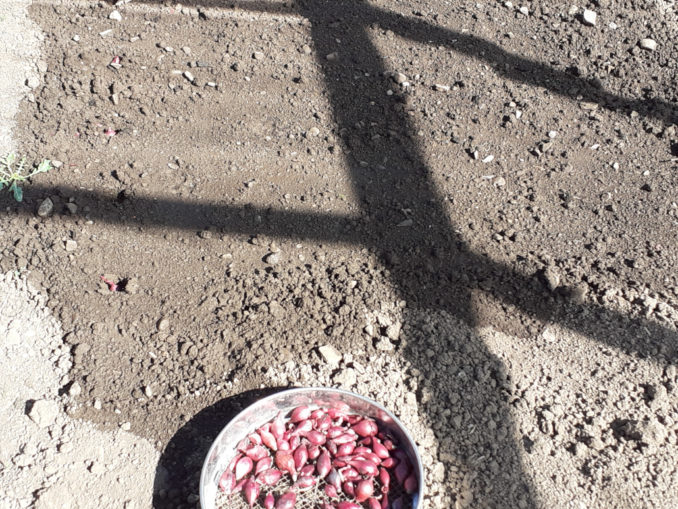
© Colin Cross, Going Postal 2020
Hello folks and welcome to part four of a guide to rough veg growing. It’s impossible to grow vegetables, even roughly, without a large number of containers, a decent space to work the magic, an amount of different growing mediums and a set of tools and gadgets, some purpose made for the job, others that fit a purpose, even if not designed to. My lock knife is invaluable, it cuts, digs, chops and makes short work of those few slugs still silly enough to attempt to steal my produce by getting over (or under) the pellets.

© Colin Cross, Going Postal 2020
I took a bit of time, earlier in the week, to collect together some of the things I make most use of and one that I bought on impulse which still hasn’t done anything apart from gather rust. From left to right; a push hoe, useful for shallow rooted weeds on the hard packed paths; a proprietary weeding tool which could join the proverbial chocolate fireguard ranks, for all the use it is; a Sharpie pen, the wet end for writing plant tags, the stubby end for use as a mini-dibber; my trusty spade, just trench wide; my hole making jigger, for making holes; two canes; my two pronged fork for close up work on deep rooted, pernicious weed; my “Trigger” rake, it’s never had a new head, but it’s had at least three shafts; secateurs; a gripe, as opposed to a fork, for digging potatoes; my self made dibber, the shape of which is purely unintentional, for dibbing; a pull hoe for use when a push hoe won’t do and finally a trowel, because every gardener needs a trowel.

© Colin Cross, Going Postal 2020
By the entrance door into the house is the base of the grape vine. This thing is a marvel of nature, it has no business being in the far north west of England but I strip it back every year and it virtually just goes to sleep. It’s covered in nodules, where the new growth comes from and has loose papery bark. At the beginning of every April I weed the area around the base, where the roots are exposed, make a soil bulwark and allow it to slowly fill with water. I repeat the process a couple of times, it hasn’t had a drink for nearly six months, and within 7-10 days growth starts to appear which, within a week or so, becomes very vigorous. I’ll water it every couple of days, maybe half a gallon at a time and I should get a great crop of lovely sweet black grapes. If you look carefully you can see some tomato plants “hardening off” in the full sun. This warm spell has been a godsend.

© Colin Cross, Going Postal 2020
One of my essential tools is a bit of stick of just the right length to allow me to mark out the holes for my tomato stitch, I think I’ve had this one a couple of years, but they aren’t difficult to replace. This is what the hole making jigger is for (it may have a different name in less rough circles). The holes are around eighteen inches apart and, once the soil is out, I fill them with water once or twice, dependent on how much each hole absorbs, until they’ve absorbed enough to encourage the roots to take hold and seek out the muck which has been breaking down for a couple of weeks. I try to be as careful as possible when taking plant from pot and place the whole thing in the hole. I gently pack the soil previously removed around the plant and give it a good water. I then say a short prayer to the god of all things tomato and hope that by carefully nurturing over the next several weeks I’ll end up with around 25 viable tomato plants.

© Colin Cross, Going Postal 2020
This week, along with planting out my tomatoes, I’ve also put my onion sets in. I don’t use the cow manure for these, although once I’ve lightly turned this area over and raked it “roughly” level I do liberally sprinkle with chicken manure before giving it a thorough soaking. This is where my dibber comes into its own. I used to plant my onion sets into very shallow holes, leaving the shoot exposed, which I thought was the “right” way to do it. Last year I tried planting them fully under soil, with the thinnest covering over them. The onions weren’t any bigger and did reach maturity a little later but there were far less occurrences of bolting and seeding, so I’ve done the same this year, although, as the old hands will tell you, no two growing seasons are the same.

© Colin Cross, Going Postal 2020
During this week, although my main focus has been on getting the tomatoes and onions in the ground, I’ve also finished off the strawberry raised beds and set aside two thirds of the centre one for salad leaves. I’ve put some chicory in this year, just because I had the seed. It seems to be doing well so far. The original plan was to put the whole bed over to salad but I couldn’t bring myself to throw away some really healthy strawberry plants, we’ll have to wait and see if I made the correct decision. I’ve got some beetroot on the go too. Beetroot is another veg that seed suppliers recommend planting directly into the ground but I like to get them started in small pots before planting out in rows. I’ve had success with this method in the past so I can’t see the point in changing. I did try direct planting a couple of years ago, with mixed results.
Even during the warmest of days at this time of year the temperature tends to drop quite markedly over night, which means an evening visit to the house to put both the tomato plants and other seedlings “to bed”. I combine this visit with watering, I have one of the large orange tubs and two watering cans which I fill with water either late at night or first thing in the morning. As the house heats up during the day so the water loses its chill, making it a decent temperature which won’t shock young plants. Once I’ve watered and had a good look around I put fleeces over the seedlings on the potting table and also over the tomatoes. If you were wondering why I leave the string line up after making the stitch then wonder no more, it’s used to support said fleeces, which help to retain the warmth of the day at ground level.
That’s me for this week, I’ve had a couple of days off but I’ll be back at it tomorrow, when I’ll be mostly doing my least favourite job, weeding. It’s an incontrovertible fact that, no matter how many weeds one hoes back, or digs up, there’s always at least two more to take their place.
Happy rough gardening.
© Colin Cross 2020
The Goodnight Vienna Audio file
Audio Player



